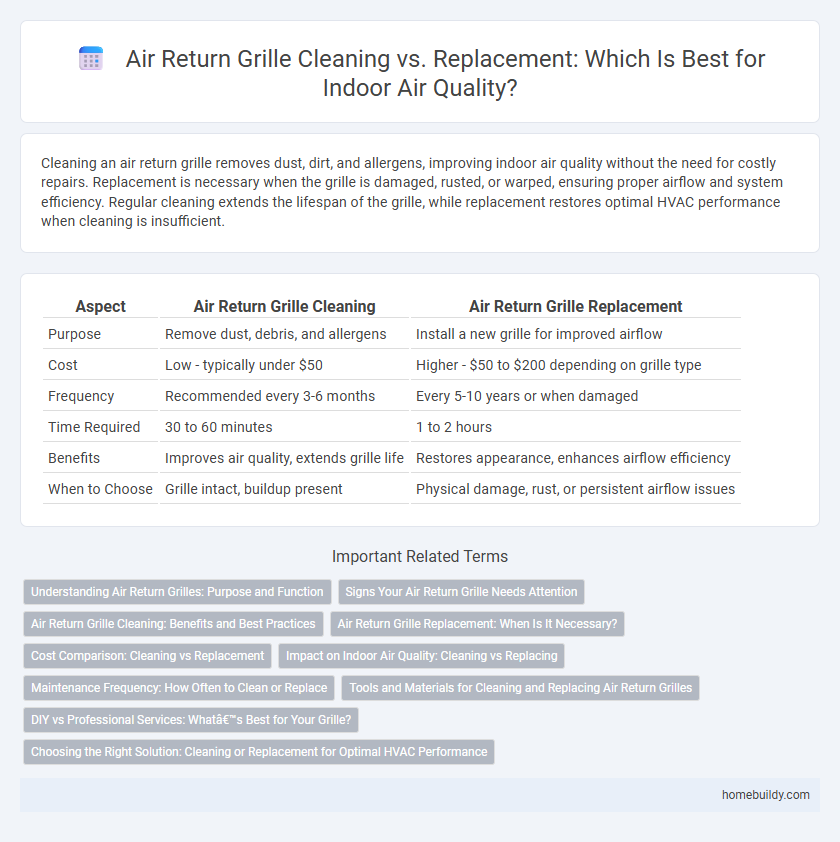Cleaning an air return grille removes dust, dirt, and allergens, improving indoor air quality without the need for costly repairs. Replacement is necessary when the grille is damaged, rusted, or warped, ensuring proper airflow and system efficiency. Regular cleaning extends the lifespan of the grille, while replacement restores optimal HVAC performance when cleaning is insufficient.
Table of Comparison
| Aspect | Air Return Grille Cleaning | Air Return Grille Replacement |
|---|---|---|
| Purpose | Remove dust, debris, and allergens | Install a new grille for improved airflow |
| Cost | Low - typically under $50 | Higher - $50 to $200 depending on grille type |
| Frequency | Recommended every 3-6 months | Every 5-10 years or when damaged |
| Time Required | 30 to 60 minutes | 1 to 2 hours |
| Benefits | Improves air quality, extends grille life | Restores appearance, enhances airflow efficiency |
| When to Choose | Grille intact, buildup present | Physical damage, rust, or persistent airflow issues |
Understanding Air Return Grilles: Purpose and Function
Air return grilles serve a crucial role in HVAC systems by facilitating the efficient circulation of air back to the furnace or air handler, maintaining balanced airflow and indoor air quality. Regular cleaning of air return grilles removes accumulated dust and debris, ensuring optimal performance and preventing strain on the HVAC system. Replacement becomes necessary when grills are damaged, corroded, or severely clogged, as compromised grilles can disrupt airflow and reduce overall system efficiency.
Signs Your Air Return Grille Needs Attention
Air return grilles showing excessive dust buildup, visible mold, or unusual odors signal the need for immediate cleaning to maintain indoor air quality and system efficiency. Cracks, broken louvers, or persistent airflow issues often indicate that replacement is necessary to ensure optimal HVAC performance. Regular inspection can detect these signs early, preventing costly repairs and health hazards.
Air Return Grille Cleaning: Benefits and Best Practices
Regular air return grille cleaning improves indoor air quality by removing dust, allergens, and debris that accumulate over time. Cleaning enhances HVAC system efficiency, reduces energy consumption, and extends the lifespan of the equipment. Best practices include using a vacuum with a brush attachment, wiping with a damp cloth, and scheduling professional cleanings periodically to ensure optimal performance.
Air Return Grille Replacement: When Is It Necessary?
Air return grille replacement becomes necessary when the grille is extensively damaged, corroded, or warped, which impairs airflow and compromises HVAC system efficiency. Persistent dirt buildup that cannot be removed through cleaning, along with cracks or broken parts, also indicate the need for replacement to maintain optimal indoor air quality. Regular inspection of the grille condition ensures timely replacement, preventing potential strain on the HVAC system and reducing energy costs.
Cost Comparison: Cleaning vs Replacement
Air return grille cleaning typically costs between $50 and $150, depending on the size and extent of debris buildup, offering an affordable maintenance option that extends grille lifespan. Replacement costs range from $200 to $600 or more, influenced by grille material, size, and labor required for installation, representing a higher upfront investment. Regular cleaning reduces the need for frequent replacements, making it a cost-effective solution for maintaining airflow efficiency and indoor air quality.
Impact on Indoor Air Quality: Cleaning vs Replacing
Regular air return grille cleaning removes dust, allergens, and microbial buildup, significantly improving indoor air quality by reducing contaminants circulated through HVAC systems. Replacing air return grilles can further enhance air quality by eliminating damaged or heavily contaminated components that are difficult to clean thoroughly. Proper maintenance through cleaning extends grille lifespan, while timely replacement ensures optimal airflow and minimizes airborne pollutants.
Maintenance Frequency: How Often to Clean or Replace
Air return grille cleaning should be performed every 3 to 6 months to prevent dust buildup and maintain optimal airflow efficiency. Replacement of air return grilles is typically necessary every 5 to 10 years, depending on material durability and environmental conditions such as moisture and debris exposure. Regular inspections help determine whether cleaning suffices or if replacement is required to ensure proper HVAC system function and indoor air quality.
Tools and Materials for Cleaning and Replacing Air Return Grilles
Air return grille cleaning requires tools such as a vacuum cleaner with a brush attachment, microfiber cloths, mild detergent, and a screwdriver to remove the grille cover. Replacement involves additional materials including a new grille that matches the duct size, screws or mounting hardware, a drill or screwdriver, and potentially sealing tape to ensure airtight installation. Proper selection of cleaning supplies and replacement components ensures optimal airflow and maintains HVAC system efficiency.
DIY vs Professional Services: What’s Best for Your Grille?
Air return grille cleaning involves removing dust and debris to improve airflow and indoor air quality, often achievable through simple DIY methods using vacuum tools and mild detergents. Replacement of an air return grille may be necessary if the grille is damaged, corroded, or severely clogged beyond cleaning, which typically requires professional assessment and installation to ensure proper fit and function. Choosing between DIY cleaning and professional replacement depends on the grille's condition, homeowner skill level, and the need for maintaining HVAC system efficiency and safety.
Choosing the Right Solution: Cleaning or Replacement for Optimal HVAC Performance
Regular air return grille cleaning removes dust, debris, and allergens, improving indoor air quality and maintaining efficient airflow in HVAC systems. Replacement becomes necessary when grilles are damaged, corroded, or significantly clogged, ensuring unobstructed air circulation and preventing strain on HVAC components. Evaluating grille condition and maintenance history helps determine the optimal choice between cleaning and replacement for sustained HVAC performance.
Air return grille cleaning vs Air return grille replacement Infographic

 homebuildy.com
homebuildy.com